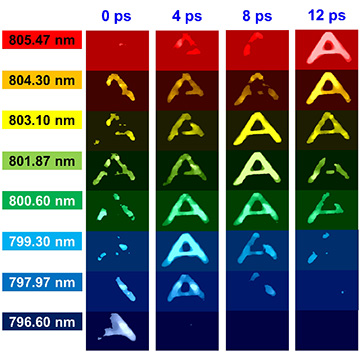
The researchers took single-shot spectral images of the letter “A” in dye, recorded at eight different wavelengths between 796.60 nm and 805.47 nm and at four different time delays by CUST photography. [Image: Y. Lu et al., Phys. Rev. Lett. (2019)]
Ultrafast photography has been an important technique for visualizing and understanding dynamic physical and chemical processes for decades. However, imaging non-repeatable ultrafast processes, such as laser surgery or laser-bio-tissue interaction, has proven more difficult. These processes must be captured in real time, and current single-shot imaging techniques face many limitations.
Now, researchers from multiple Chinese institutions have developed an imaging technique that they say can record transient, highly complex and non-repetitive events with ultrahigh spectral or temporal resolution, a large frame number and femtosecond-scale speed (Phys. Rev. Lett., doi: 10.1103/PhysRevLett.122.193904). The method, which the team has dubbed compressed ultrafast spectral-temporal photography (CUST), could be a new tool for imaging ultrafast phenomena with abundant temporal and spatial details.
Frame rate–frame number balancing act
Modern scientific cameras can take trillions of images per second—fast enough to capture molecules interacting with one another. However, these cameras rely on semiconductor structures called CCD arrays to temporarily store image data, and the limited CCD space forces a sacrifice in the number of frames given the fastest fs-scale frame rates. That means in practice that a single exposure can result in just a handful of images. Though recent years have seen progress in single-shot ultrafast photography techniques, these methods still struggle to compromise between imaging speed, spectral resolution and frame number.
To overcome these limitations, the research team, led by Lidai Wang of the City University of Hong Kong, built on a current single-shot ultrafast photography technique, compressive sampling, and applied the principle of spectral–temporal coupling of fs laser pulses—along with some computational imaging algorithms for good measure. In the setup, a laser pulse containing a narrow range of frequencies is sent through a system of lenses and diffraction gratings to form a stretched, longer-duration chirped pulse—which then transmits through an ultrafast object. Next, the temporal or spectral information is spatially encoded and compressed into a single 2-D image. Multiple images are then reconstructed from this single 2-D image using a compressed-sensing algorithm.
By encoding the images and then decoding them in this way, the still frames from the pulse can be stored in overlapping regions of the CCD array and still be reassembled in a time-ordered video. “The decoding scheme essentially un-mixes the overlapped images,” team member Terence Wong, Hong Kong University of Science and Technology, told the American Physical Society’s online magazine Physics. “This way we can pack more images onto the same sensor.”
Longer videos from a single exposure
Putting CUST to the test, the researchers recorded in real time the propagation, reflection and self-focusing of fs laser pulses. In a single shot, they captured over 60 frames of ultrafast images with ultrahigh sub-nanometer spectral resolution, achieving a frame rate of 3.85-trillion-Hz. They also recorded a 60-frame video, with a 414-fs frame interval, of a moving light pulse reflecting off of a mirror. To demonstrate CUST’s ultrafast spectral imaging capability, the team captured dozens of quick spectral snapshots of the letter “A” filled with dye, with each image covering part of a narrow range of wavelengths from 795.21 to 806.60 nm, within a picosecond timescale.
According to the team, these results show that CUST photography is capable of imaging ultrafast processes with an fs-scale speed and a large frame number. Further, the scientists suggest that the method will facilitate the research of ultrafast processes in various fields, including physics, chemistry and biology. For example, with further development, Wong suggested to APS’s Physics that CUST photography might also be used “as an advanced imaging tool to inspect biological samples in laser surgeries and imaging-based disease diagnostics.” Considering the low cost of the method compared to ultrafast photography dependent on expensive streak cameras, the team foresees a wide range of applications.
The researchers recognize some limitations for CUST photography—the method relies on a chirped pulse to illuminate the ultrafast process, so self-illuminating, fluorescent processes would be challenging to record. Also, the compressed-sensing method could be further optimized to improve the reconstructed image quality.
